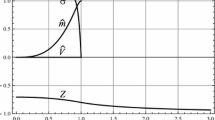Abstract
The influence of the quantum nature of gravity on the distribution of matter-energy in a gravitational system with the maximally symmetric geometry is studied. The state vector of the quantum gravitational system (QGS) satisfies the set of wave equations which describes the time evolution of a quantum system in the space of quantum fields. It is shown that this state vector can be normalized to unity. The generalization of the wave equations to the domain of negative values of the cosmic scale factor is made. For the arrow of time from past to future, the state vector describes the QGS contracting for the negative values of the scale factor and expanding for its positive values. The intensity distributions of matter are calculated for two exactly solvable models of spatially closed and flat QGSs formed by dust and radiation. The analogies with the motion in time of minimum wave packet for spatially closed QGS and with the phenomenon of diffraction in optics for flat QGS are drawn.




Similar content being viewed by others
Notes
It is convenient to formulate quantum theory in terms of dimensionless variables and parameters, in which length is measured in modified units of Planck length \(l_\mathrm{P} = \sqrt{2 G \hbar / (3 \pi c^{3})}\), proper time is expressed in Planck time units \(t_\mathrm{P} = l_\mathrm{P} / c\), and mass-energy is taken in Planck mass units \(m_\mathrm{P} = \hbar / (l_\mathrm{P} c)\). The Planck density \(\rho _\mathrm{P} = 3 c^{4} / (8 \pi G l_\mathrm{P}^{2})\) is used as a unit of energy density and pressure. The scalar field is taken in \(\phi _\mathrm{P} = \sqrt{3 c^{4} / (8 \pi G)}\). Here G is Newton’s gravitational constant.
References
Dirac, P.A.M.: The theory of gravitation in Hamiltonian form. Proc. R. Soc. A246, 333–343 (1958)
Arnowitt, R., Deser, S., Misner, C.M.: The dynamics of general relativity. In: Witten, L. (ed.) Gravitation: An Introduction to Current Research. Wiley, New York (1962)
DeWitt, B.S.: The quantization of geometry. In: Witten, L. (ed.) Gravitation: An Introduction to Current Research, pp. 305–318. Wiley, New York (1962)
DeWitt, B.S.: Quantum theory of gravity. I. The canonical theory. Phys. Rev. 160, 1113–1148 (1967)
Wheeler, J.A.: Superspace and nature of quantum geometrodynamics. In: DeWitt, C., Wheeler, J.A. (eds.) Battelle Rencontres, pp. 242–307. Benjamin, New York (1968)
Kuchař, K.V., Torre, C.G.: Gaussian reference fluid and interpretation of quantum geometrodynamics. Phys. Rev. D 43, 419–441 (1991)
Kuchař, K.V.: Time and the interpretations of quantum gravity. In: Kunstatter, G., Vincent, D., Williams, J. (eds.) Proceedings of the 4th Canadian Conference on General Relativity and Relativistic Astrophysics, pp. 211–314. World Scientific, Singapore (1992)
Torre, C.G.: Is general relativity an “already parametrized” theory? Phys. Rev. D 46, R3231–R3234 (1992)
Isham, C.J.: Structural issues in quantum gravity. In: Francaviglia, M., Longhi, G., Lusanna, L., Sorace, E. (eds.) General Relativity and Gravitation: GR14, pp. 167–209. World Scientific, Singapore (1997). arXiv:gr-qc/9510063
Brown, J.D., Marolf, D.: On relativistic material reference systems. Phys. Rev. D 53, 1835–1844 (1996). arXiv:gr-qc/9509026
Kuzmichev, V.E.: Kuzmichev,V.V.: Properties of the quantum universe in quasistationary states and cosmological puzzles. Eur. Phys. J. C 23, 337–348 (2002). arXiv:astro-ph/0111438
Kuzmichev, V.E., Kuzmichev, V.V.: The Big Bang quantum cosmology: the matter-energy production epoch. Acta Phys. Pol. B 39, 979–995 (2008). arXiv:0712.0464 [gr-qc]
Kuzmichev, V.E., Kuzmichev, V.V.: Quantum evolution of the very early Universe. Ukr. J. Phys. 53, 837–844 (2008)
Lund, F.: Canonical quantization of relativistic balls of dust. Phys. Rev. D 8, 3253–3259 (1973)
Demaret, J., Moncrief, V.: Hamiltonian formalism for perfect fluids in general relativity. Phys. Rev. D 21, 2785–2793 (1980)
Kuzmichev, V.E., Kuzmichev, V.V.:: Accelerating quantum Universe. Acta Phys. Pol. B 39, 2003–2018 (2008). arXiv:0712.0465 [gr-qc]
Kuzmichev, V.E, Kuzmichev, V.V.: Semi-classical Universe near initial singularity. Acta Phys. Pol. B 40, 2877–2891 (2009). arXiv:0905.4142 [gr-qc]
Kuzmichev, V.E., Kuzmichev, V.V.: Quantum Universe on extremely small space-time scales. Ukr. J. Phys. 55, 626–635 (2010)
Kuzmichev, V.E., Kuzmichev, V.V.: Quantum corrections to the dynamics of the expanding Universe. Acta Phys. Pol. B 44, 2051–2073 (2013). arXiv:1307.2383 [gr-qc]
Kuzmichev, V.E., Kuzmichev, V.V.: The expanding Universe: change of regime. Ukr. J. Phys. 60, 664–674 (2015)
Kuzmichev, V.E., Kuzmichev, V.V.: Can quantum geometrodynamics complement general relativity? Ukr. J. Phys. 61, 449–458 (2016)
Patrignani, C., et al. (Particle Data Group): The review of particle physics. Chin. Phys. C 40, 100001–101808 (2016)
Kuzmichev, V.V.: Quantum Friedmann universe. Yad. Fiz. 60, 1707–1719 (1997)
Kuzmichev, V.V.: Quantum Friedmann universe. Phys. Atom. Nucl. 60, 1558–1569 (1997)
Kanekar, N., Sahni, V., Shtanov, Y.: Recycling the universe using scalar fields. Phys. Rev. D 63, 083520–083529 (2001)
Lyth, D.H., Riotto, A.: Particle physics models of inflation and the cosmological density perturbation. Phys. Rep. 314, 1–146 (1999)
Landau, L.D., Lifshitz, E.M.: Quantum Mechanics, vol. 3. Pergamon Press, Oxford (1965)
Landau, L.D., Lifshitz, E.M.: The Classical Theory of Fields, vol. 2. Butterworth-Heinemann, Amsterdam (1975)
Author information
Authors and Affiliations
Corresponding author
Rights and permissions
About this article
Cite this article
Kuzmichev, V.E., Kuzmichev, V.V. The matter-energy intensity distribution in a quantum gravitational system. Quantum Stud.: Math. Found. 5, 245–255 (2018). https://doi.org/10.1007/s40509-017-0115-0
Received:
Accepted:
Published:
Issue Date:
DOI: https://doi.org/10.1007/s40509-017-0115-0




